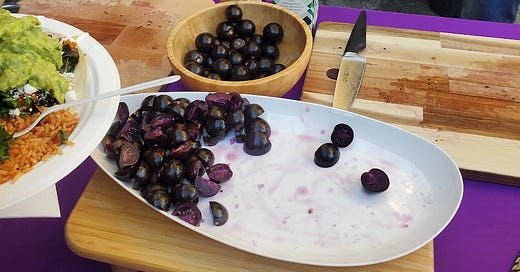For a long time, plant biologists have dreamt of using their skills to make our food not only delicious but also healthier. Recently at SynBioBeta 2023, the fruit of that labor- was the purple tomato.

Why is my tomato purple?
Anthocyanins are a group of pigments found in various plants associated with numerous health benefits such as protection against cancers, cardiovascular disease, age-related degenerative diseases, and anti-inflammatory properties.
Scientists took on the challenge of engineering tomatoes to accumulate significantly higher levels of anthocyanins by introducing two transcription factors from snapdragon flowers into tomato plants. This breakthrough resulted in the production of tomatoes with anthocyanin concentrations comparable to those found in blackberries and blueberries.
What’s the big deal?
In the original paper, Trp53−/− mice, which are susceptible to cancer demonstrated a significant extension in their lifespan when fed a diet supplemented with genetically modified tomatoes, indicating the positive effects of a high-anthocyanin diet.
What’s the bigger deal?
A New Regulatory Status Review (RSR)… United States Department of Agriculture's Animal and Plant Health Inspection Service (USDA-APHIS) concluded that these tomatoes are unlikely to pose an increased plant pest risk compared to conventional tomatoes and are therefore not subject to regulation under the SECURE (Sustainable, Ecological, Consistent, Uniform, Responsible, Efficient) rule.
The SECURE rule replaced the previous regulations for genetically engineered organisms. It streamlined the regulatory process, focusing more on the properties of the engineered organism rather than the methods used to produce it. No permit is needed- at least from USDA ✅ This means that the purple tomato can be legally imported, moved interstate, or released into the environment (such as in field trials) without a permit from APHIS.
Plant Species, Trait, and Mechanism of Action (PTMOA) exemption.
This allows other genetically engineered tomatoes with the same plant species, trait, and mechanism of action to be exempted.
BUT while USDA-APHIS has granted this approval, other regulatory agencies such as the Food and Drug Administration (FDA) and the Environmental Protection Agency (EPA) still have their own regulations and requirements that need to be considered.
So.. it still may be a little longer before you see these healthy and delicious fruits on your plate.






As Gen Z, have you considered posting to TikTok? This is super cool and informative! Gen Z loves plants too haha 📈🌿